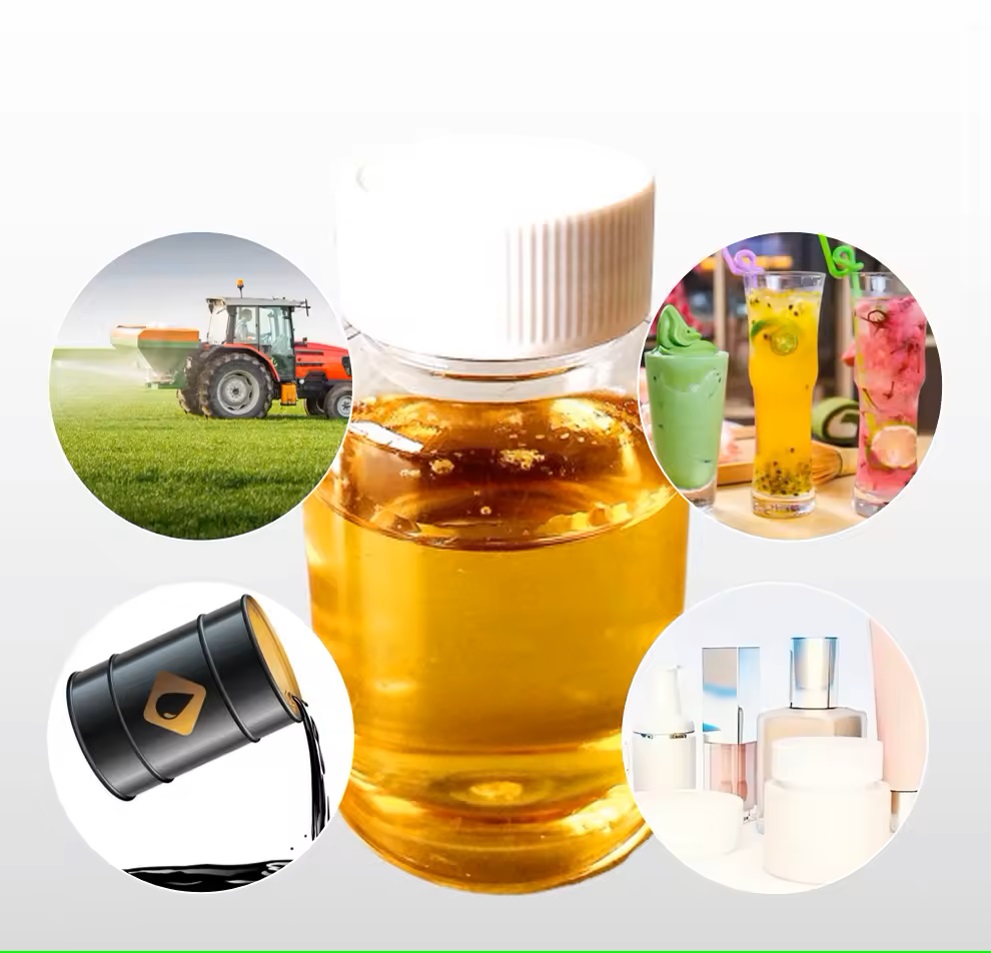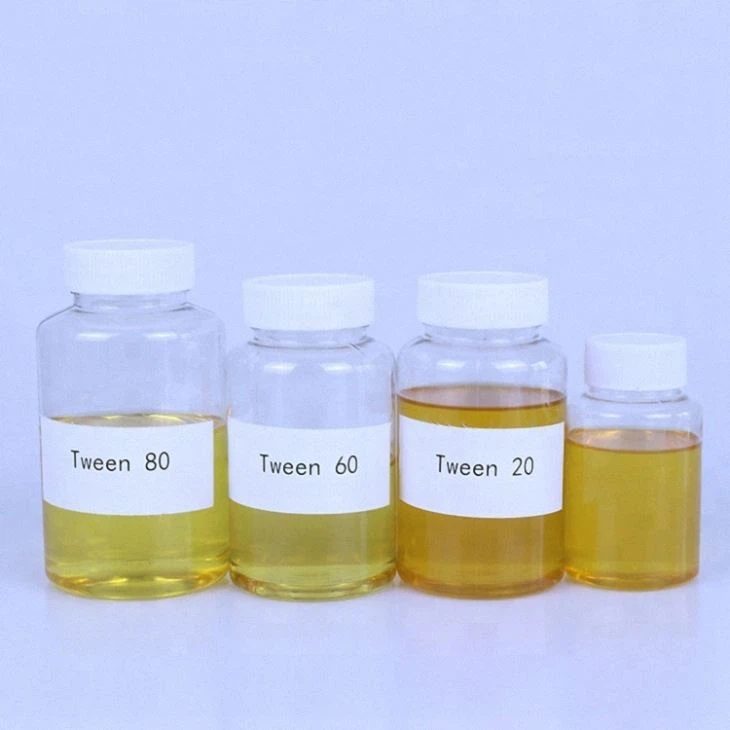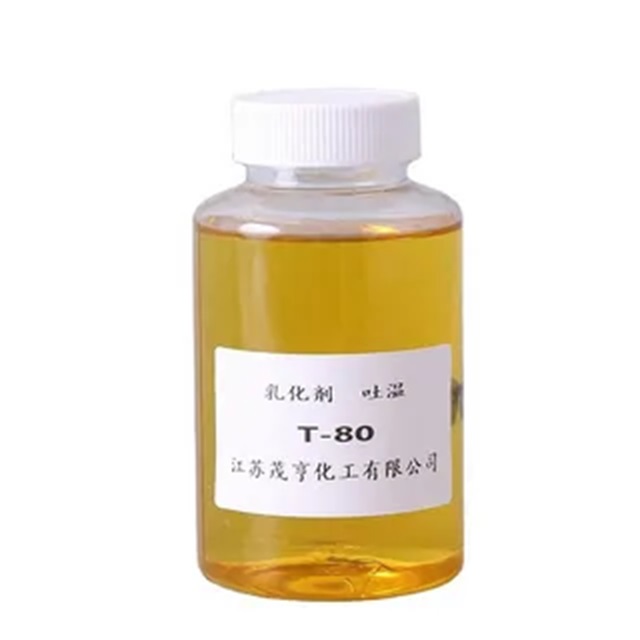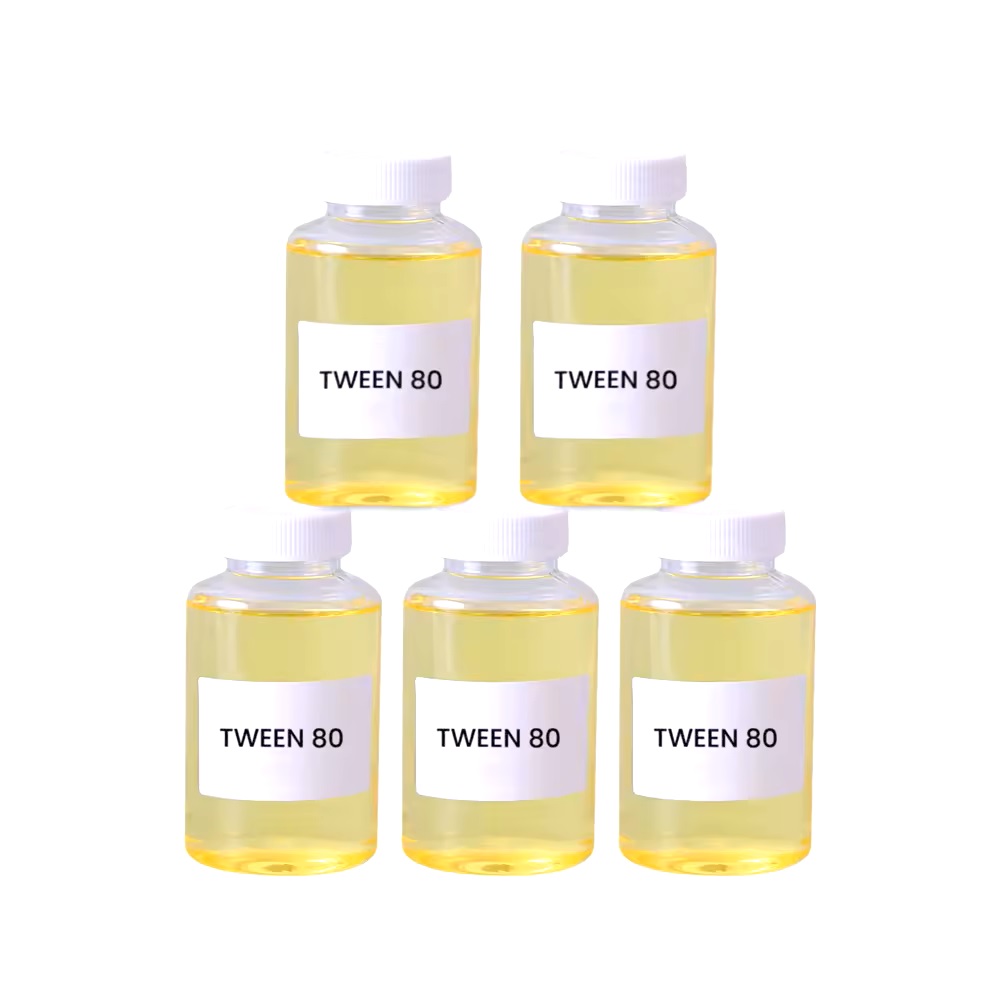We unleash your business potential by maximize the business innovation.
Send EmailTween 20, Polisorbate 20, PS 20, Twain 20, Emulsifier T-20, Polisorbate 20, Polyoxyethylene Sorbitan Monolaurate, Polisorbat 80, 9005-64-5
🧴 Polysorbates Overview
Polysorbates are widely used nonionic surfactants and emulsifiers, commonly known under the trade name Tween®. They come in various types—Polysorbate 20, 40, 60, 65, and 80—each derived from sorbitan esters of different fatty acids and ethylene oxide chains. Their HLB (Hydrophilic-Lipophilic Balance) values vary depending on the fatty acid used.
🔬 What Is a Polysorbate?
-
Chemical Structure: Sorbitol + Fatty Acid + Polyethylene Oxide
-
CAS Number: For example, Polysorbate 20 → 9005-64-5
-
Form: Typically light yellow liquid
-
HLB Values:
-
Polysorbate 20 → ~16.7 (ideal for water-phase emulsions)
-
Polysorbate 80 → ~15.0 (better for oil-phase systems)
-
🧪 Applications by Industry
| Industry | Usage Description |
|---|---|
| Cosmetics | Creams, lotions, shampoos, perfumes – emulsifier and solubilizer |
| Food | Emulsifier (E432–E436), flavor carrier, stabilizer |
| Pharmaceuticals | Solubilizer and dispersant in injectable formulations |
| Biotechnology | Protein stabilization in cell culture media |
| Industrial | Surfactant in paints, inks, and cleaning products |
🏭 Production Process
Polysorbates are produced by:
-
Dehydrating sorbitol to form sorbitan
-
Esterifying with a fatty acid (e.g., oleic acid for Polysorbate 80)
-
Polymerizing with ethylene oxide
For example, Polysorbate 80 is synthesized from sorbitan monooleate and ethylene oxide.
⚠️ Key Considerations
-
Purity level and HLB value are critical for formulation performance
-
SML (Specific Migration Limit) values are important in food and pharma applications
-
Tween 20 and Tween 80 are the most commonly used commercial names
🧪 Polysorbate Types and Technical Details
| Trade Name | Chemical Name | CAS No | HLB Value | Fatty Acid Source | Common Uses |
|---|---|---|---|---|---|
| Polysorbate 20 | Polyoxyethylene (20) sorbitan monolaurate | 9005-64-5 | ~16.7 | Lauric Acid | Cosmetics, food |
| Polysorbate 40 | Polyoxyethylene (20) sorbitan monopalmitate | 9005-66-7 | ~15.6 | Palmitic Acid | Food, pharmaceuticals |
| Polysorbate 60 | Polyoxyethylene (20) sorbitan monostearate | 9005-67-8 | ~14.9 | Stearic Acid | Food, cosmetics |
| Polysorbate 65 | Polyoxyethylene (20) sorbitan tristearate | 9005-71-4 | ~10.5 | Tristearic Acid | Bakery, food |
| Polysorbate 80 | Polyoxyethylene (20) sorbitan monooleate | 9005-65-6 | ~15.0 | Oleic Acid | Pharma, biotech |
🧾 Synonyms and Alternate Names
Polysorbates may also be listed as:
-
Tween® 20 / 40 / 60 / 65 / 80
-
PS 20 / PS 80
-
Emulsifier T-20 / T-80
-
Polyoxyethylene sorbitan mono[fatty acid]
-
Twain 20 / Twain 80 (in some catalogs)
-
E432–E436 (EU food additive codes)
Tween(R) 20
CAS: 9005-64-5
Molecular Formula: C26H50O10
Names and Identifiers
| Name | Tween(R) 20 |
| Synonyms | Twain 20 tween 20 Tween-20 Tween(R) 20 Emulsifier T-20 Polisorbate 20- PS 20 TWEEN 20 ELECTROPHORESIS GRADE polyoxyethylene sorbitan monolaurate Polyethyleneglycol sorbitan monolaurate Tween 20 (Trademark of ICI America, Inc.) 3,6-anhydro-1-O-[2-(dodecanoyloxy)ethyl]-2,4,5-tris-O-(2-hydroxyethyl)hexitol 2-hydroxyethyl 2-deoxy-3,5-bis-O-(2-hydroxyethyl)-6-O-{2-[(9E)-octadec-9-enoyloxy]ethyl}hexofuranoside |
| CAS | 9005-64-5 |
| EINECS | 500-018-3 |
| InChI | InChI=1/C32H60O10/c1-2-3-4-5-6-7-8-9-10-11-12-13-14-15-16-17-30(36)40-25-24-37-27-29(39-22-19-34)32-28(38-21-18-33)26-31(42-32)41-23-20-35/h9-10,28-29,31-35H,2-8,11-27H2,1H3/b10-9+ |
Physico-chemical Properties
| Molecular Formula | C26H50O10 |
| Molar Mass | 522.6692 |
| Density | 1.11g/mLat 20°C |
| Melting Point | 98.9 °C (decomp) |
| Boling Point | 100 °C |
| Flash Point | >230°F |
| Water Solubility | 100 g/L |
| Solubility | 100 g/L |
| Vapor Presure | <1.4 hPa (20 °C) |
| Appearance | Bright yellow liquid |
| Specific Gravity | 1.090~1.130 (20/20℃) |
| Color | Amber |
| PH | 6-8 (50g/l, H2O, 20℃) |
| Storage Condition | Store below +30°C. |
| Stability | Stable. Incompatible with strong oxidizing agents. |
| Sensitive | Easily absorbing moisture |
| Refractive Index | n20/D 1.468(lit.) |
| MDL | MFCD00165986 |
| Physical and Chemical Properties | Density 1.106 boiling point 100°C ND20 1.4685-1.4715 water solubility 100g/L |
| Use | Can be used as solubilizer, diffusing agent, stabilizer, antistatic agent, lubricant, etc |
Risk and Safety
| Hazard Symbols | Xi - Irritant |
| Risk Codes | R22 - Harmful if swallowed R36/37/38 - Irritating to eyes, respiratory system and skin. R37/38 - Irritating to respiratory system and skin. R41 - Risk of serious damage to eyes |
| Safety Description | S24/25 - Avoid contact with skin and eyes. S36/37/39 - Wear suitable protective clothing, gloves and eye/face protection. S36 - Wear suitable protective clothing. S26 - In case of contact with eyes, rinse immediately with plenty of water and seek medical advice. |
| WGK Germany | 1 |
| RTECS | TR7400000 |
| FLUKA BRAND F CODES | 10-23 |
| TSCA | Yes |
| HS Code | 34021300 |
| Toxicity | LD50 orally in Rabbit: 38900 mg/kg |
Standard
This line of lauryl sorbate and ethylene oxide polymerization of polyoxyethylene 20 lauryl sorbate.
Trait
- This product is light yellow or yellow viscous oily liquid; Slightly odorless.
- This product is soluble in water, ethanol, methanol or ethyl acetate, slightly soluble in liquid paraffin.
relative density
The relative density of this product (General 0601) is 1.09~1.12.
viscosity
The kinematic viscosity of this product (General rule 0633 first method) is 250~400/s at 25°C (capillary inner diameter is or suitable capillary inner diameter).
acid value
take about 10g of this product, accurately weigh it, put it in 250ml Erlenmeyer flask, add 50ml neutral ethanol (neutral to phenolphthalein indicator solution) to dissolve, heat and reflux for 10 minutes, and let it cool, add phenolphthalein indicator solution 5 drops, with sodium hydroxide titration solution (0.lmol/L) titration, acid value (General 0713) shall not exceed 2 .0.
saponification value
The saponification value of this product (General 0713) is 40~50.
hydroxyl value
The Hydroxyl value of this product (General 0713) is 96~108.
perchlorination value
The peroxide value of this product (General rule 0713) shall not exceed 10.
Introduction
Nonionic surfactants. Separation and analysis of volatile oil, fatty acid ester, alcohol, ketone and halide by gas chromatography stationary solution (maximum service temperature 120 ℃). Water-soluble emulsifier. Add solvent. Antistatic agents and fiber lubricants for the textile industry.
Differential diagnosis
- take 5ml of aqueous solution (1-20) of this product, add 5ml of sodium hydroxide solution, boil for several minutes, let cool, acidify with dilute hydrochloric acid, and show milky white turbidity.
- Take 2ml of the aqueous solution (1-20) of this product and add 0.5ml of bromine test solution dropwise. The bromine test solution will not fade.
- take 10ml of aqueous solution (1-20) of this product, add 5ml of cobalt ammonium thiocyanate solution (take 17.4g of ammonium thiocyanate and 2.8g of cobalt nitrate, add water to dissolve 100ml), mix well, add 5ml of chloroform, after shaking and mixing and standing, the chloroform layer was blue.
Exam
pH
take 0.50g of this product, Add 10ml of water to dissolve, and measure according to law (General rule 0631). The pH value should be 4.0~7.5.
Color
take 10ml of this product, and compare it with the same volume of control solution (take 8.0ml of potassium dichromate solution for color comparison and 0.8ml of cobalt chloride solution for color comparison, add water to 10ml), and not be deeper.
ethylene glycol and diethylene glycol
take about 4g of this product, precision weighing, 100ml measuring flask, precision plus internal standard solution (take 1, 3-butanediol appropriate amount, prepare a solution containing about 4mg per 1 ml of acetone) 1 ml, dilute to the scale with acetone, shake well, and use as a test solution; Take ethylene glycol and diethylene glycol, each about 40mg, precision weighing, in the same 100ml measuring flask, dilute to the scale with acetone, shake well, take 10ml and put it in another 100ml measuring flask, add lml of internal standard solution, dilute to the scale with acetone, shake well as a control solution. Gas phase
Chromatography (General 0521) test. With 50% phenyl-50% methyl polysiloxane as stationary liquid (column length 30m, inner diameter 0.53, membrane thickness 1.0um), the initial temperature was 40°C, and the temperature was raised to 60°C at a rate of 10°C per minute, after holding for 5 minutes, the temperature was raised to 170°C at a rate of 10°C per minute and then to 280°C at a rate of 15°C per minute for 60 minutes (which can be adjusted according to the specific situation). The inlet temperature was 270°C and the detector temperature was 290°C. Take the reference solution as the system suitability test solution, the separation degree between peaks shall not be less than 2.0, and the tailing factor of each peak shall meet the requirements. 1ul of test solution and 1ul of reference solution were injected separately, and the chromatogram was recorded. According to the internal standard method based on peak area, ethylene glycol and diethylene glycol shall not exceed 0.01%.
Ethylene oxide and dioxane
take this product about lg, precision weighing, top empty bottle, precision plus ultrapure water 1.0ml, sealed, shake, as a test solution; an appropriate amount of the ethylene oxide control stock solution was accurately weighed, placed in a measuring flask, and treated polyethylene glycol 400 (1.5 to 2 at 60°C) was added. 5kPa rotary evaporation for 6 hours to remove volatile components) dissolved and diluted to prepare a solution containing about 1 ug per 1 ml as an ethylene oxide control solution. In addition, an appropriate amount of dioxane was carefully weighed, and a solution containing about 10ug per 1 ml of water was prepared as a control solution of dioxane. Take about 1g of this product, precision weighing, top empty bottle, precision plus ethylene oxide reference solution and dioxane reference solution of 0.5, sealed, shake. As a control solution. Add 0.1 ml of freshly prepared 0.001% acetaldehyde solution and 0.5ml of dioxane control solution to the headspace bottle, seal and shake. As a system suitability test solution. Test according to Gas chromatography (General 0521). With polydimethylsiloxane as the stationary liquid, the initial temperature is 35°C, the temperature is maintained for 5 minutes, the temperature is raised to 180°C at a rate of 5°C per minute, and then the temperature is raised to 230°C at a rate of 30°C per minute, maintain 5 minutes (can be adjusted according to the specific situation). The inlet temperature was 150°C and the detector temperature was 250°C. The Headspace equilibrium temperature is 70°C, and the equilibrium time is 45 minutes. The system suitability test solution is sampled in the headspace, the flow rate is 2.5ml per minute, and the split ratio is 1:20. Adjust the sensitivity of the instrument so that the peak height of ethylene oxide peak and acetaldehyde peak is 15% of the full scale, and the separation degree of acetaldehyde peak and ethylene oxide peak is not less than 2.0,
The peak height of dioxane should be at least 5 times higher than the baseline noise. The test solution and the reference solution were respectively injected in Headspace, and the injection was repeated for at least 3 times. The relative standard deviation of the peak area of ethylene oxide should not exceed 15%, and the relative standard deviation of the peak area of dioxane should not exceed 10%. Calculated by Standard addition method, containing no more than 0.0001% of ethylene oxide and no more than 0.001% of dioxane.
moisture
take this product, according to the determination of moisture (General 0832 first method 1), the water content shall not exceed 3.0%.
ignition residue
take l.Og of this product and check it according to law (General rule 0841). The residue left shall not exceed 0.25%.
Heavy metals
The residue left under the item of taking the ignition residue shall not contain more than 10 parts per million of heavy metal when examined by law (General Principles 0821, Law II).
arsenic salt
take this product l.Og, put in a Kjeldahl Flask, add 5ml of sulfuric acid, digest with small fire to carbonize, control the temperature not to exceed 120°C (sulfuric acid can be added if necessary, the total amount is not more than 10ml), carefully add concentrated hydrogen peroxide solution Dropwise, once the reaction is stopped, continue heating, and add concentrated hydrogen peroxide solution Dropwise until the solution is colorless, cool, add 10ml of water, and evaporate until thick smoke occurs to remove hydrogen peroxide, add hydrochloric acid 5ml and water appropriate amount, according to the law inspection (General Principles 0822 The first law), should comply with the provisions (not through 0. 0002%).
fatty acid composition
take about 0.lg of this product, put it in a 50ml Erlenmeyer flask, add 2ml of 2% sodium hydroxide methanol solution, heat and reflux in a 65°C water bath for 30 minutes, cool, add 2ml of 14% boron trifluoride methanol solution, refluxing in a water bath for 30 minutes, cooling, adding 4ml of n-heptane, heating and refluxing in the water bath for 5 minutes, cooling, adding 10ml of saturated sodium chloride solution, shaking, and allowing to stand to separate layers, the upper layer liquid was taken and washed 3 times with water, each time 4ml, and the upper layer liquid was dried over anhydrous sodium sulfate, and then used as a test solution. Test according to Gas chromatography (General 0521). A quartz capillary column (0.32mm X 30m, membrane thickness 0.50um) with polyethylene glycol 20m as stationary liquid was used as the column, with an initial temperature of 90°C, and the temperature was raised to 160°C at a rate of 20°C per minute, the temperature was maintained for 1 minute and then increased to 220°C at a rate of 2°C per minute for 20 minutes; The inlet temperature was 190°C; And the detector temperature was 250°C. Acetic acid methyl ester, methyl octanoate, methyl decanoate, methyl laurate, methyl myristate, methyl palmitate, methyl stearate, methyl oleate and methyl linoleate were weighed, dissolved in n-heptane and prepared to contain methyl caproate in each lml, methyl octanoate, methyl decanoate, methyl laurate O.lmg, methyl myristate, methyl palmitate, methyl stearate, methyl oleate and methyl linoleate each contain about 1 mg of mixed solution. 1ul was injected into human gas chromatograph and the chromatogram was recorded, the resolution of each chromatographic peak shall meet the requirements. The test solution 1M1 was injected into the gas chromatograph, and the chromatogram was recorded. Calculated by area normalization method (peaks with a peak area of less than 0.05% are negligible). Containing lauric acid should be 40.0% ~ 60.0%, containing myristic acid should be 14.0% ~ 25.0%, containing palmitic acid should be 7.0% ~ 15.0%, containing caproic acid, caprylic acid, capric acid, stearic acid, oleic acid and linoleic acid respectively shall not be greater than 1.0%, 10.0%, 10.0%.7.0% , 11.0% and 3.0%.
Category
pharmaceutical excipients, emulsifiers and wetting agents.
Storage
light shielding, sealed storage.
Reference Information
| FEMA | 2915 | POLYSORBATE 20 |
| pH range of acid-base indicator discoloration | 7 |
| hydrophilic-lipophilic balance (HLB value) | 16.7 |
| identification test | solubility soluble in water, ethanol, methanol, ethyl acetate and dioxane; Insoluble in mineral oil and petroleum ether. According to the OT-42 method. Fatty Acid Test 5ml of 5% sample solution was taken, and 5ml of sodium hydroxide test solution (TS-224) was added. It was boiled for several minutes, cooled and acidified with dilute hydrochloric acid (TS-117). The solution was strongly milky white due to the release of fatty acids. Identification method 3 is the same as in "polyoxyethylene (8) stearate (10021). After saponification of 100g sample by alkali saponification, about 16g fatty acids and 8lg Polyols can be produced. The determination method is shown in "polyoxyethylene (8) stearate (10021)". |
| content analysis | ethylene oxide content was determined by the OT-36 method. |
| toxicity | ADI 0-25mg/kg(FAO/WHO,2001). LD50 37g/kg (rat, oral). |
| Use limit | is moderately limited (FDA § 172.515,2000). FEMA(mg/kg): Beverage 41; Candy 75. Has the ability to improve the body's absorption of liquid paraffin and other fat-soluble substances. GB 2760-1996(g/kg): moon cake 0.5; Juice beverage 0.75; Ice cream 1.5; Vegetable protein beverage 2.0. |
| purpose | O/W food emulsifier, used alone or with span -60, span -65, span -80 mixed. China's regulations can be used for ice cream, the maximum use of 1.5g/kg; The maximum use of 0.75g/kg in fruit juice beverages; The maximum use of 0.5g/kg in moon cakes. A non-ionic surfactant. can be used as solubilizer, diffusing agent, stabilizer, antistatic agent, lubricant, etc. used as emulsifier This product is an oil-in-water emulsifier, can be used as solubilizer, diffusing agent, stabilizer, lubricants and antistatic agents. As a wax inhibitor in oil well production, it can remove the wax in oil well. As a viscosity reducer, it can reduce the flow viscosity of crude oil, increase the output of oil well and improve the transportation ability. It is used as a solubilizer, penetrant and dispersant for drugs and cosmetics in medicine and daily chemical industry. Because this product has anti-rust and lubricating properties and thus used for the preparation of anti-rust lubricating oil and de-rust grease trace oil. |
| production method | put 1 mol silica disk 20 into the reaction kettle, add 50% liquid alkali as catalyst under stirring, gradually raise the temperature, dehydrate under reduced pressure, replace the air in the kettle with nitrogen after removing the water, raise the temperature to 120 ℃, start feeding 20 mol of ethylene oxide, and maintain the reaction temperature at 150~170 ℃, pressure 0.2~0.3 MPa. After passing the ethylene oxide, it is cooled to 80~90 ℃, and the feed liquid is charged into the neutralization pot and neutralized with glacial acetic acid, and then decolorized with hydrogen peroxide, finally cooled and decolorized, finally cooled and discharged, and the package is the finished product. Under the catalysis of sodium methoxide (or sodium ethoxide), a certain amount of ethylene oxide is introduced into span-20 at 130~170 ℃ to produce an addition reaction. |
Application
Polysorbate 20 60 80/ Tween 20 60 80 is used as O/W food emulsifier, it can be used alone or mixed with Span-60, Span-65, Span-80.
In China, Polysorbate 20 60 80/ Tween 20 60 80 can be used for ice cream, and the maximum usage is 1.5g/kg; the maximum usage in fruit juice drinks is 0.75g/kg; the maximum usage in moon cakes is 0.5g/kg.



